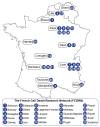Keeping Cell Death Alive: An Introduction into the French Cell Death Research Network
- PMID: 35883457
- PMCID: PMC9313292
- DOI: 10.3390/biom12070901
Keeping Cell Death Alive: An Introduction into the French Cell Death Research Network
Abstract
Since the Nobel Prize award more than twenty years ago for discovering the core apoptotic pathway in C. elegans, apoptosis and various other forms of regulated cell death have been thoroughly characterized by researchers around the world. Although many aspects of regulated cell death still remain to be elucidated in specific cell subtypes and disease conditions, many predicted that research into cell death was inexorably reaching a plateau. However, this was not the case since the last decade saw a multitude of cell death modalities being described, while harnessing their therapeutic potential reached clinical use in certain cases. In line with keeping research into cell death alive, francophone researchers from several institutions in France and Belgium established the French Cell Death Research Network (FCDRN). The research conducted by FCDRN is at the leading edge of emerging topics such as non-apoptotic functions of apoptotic effectors, paracrine effects of cell death, novel canonical and non-canonical mechanisms to induce apoptosis in cell death-resistant cancer cells or regulated forms of necrosis and the associated immunogenic response. Collectively, these various lines of research all emerged from the study of apoptosis and in the next few years will increase the mechanistic knowledge into regulated cell death and how to harness it for therapy.
Keywords: apoptosis; cancer; cell death; necrosis.
Conflict of interest statement
The authors declare no conflict of interest.
Figures
Similar articles
-
Noncanonical cell death in the nematode Caenorhabditis elegans.Methods Enzymol. 2014;545:157-80. doi: 10.1016/B978-0-12-801430-1.00007-X. Methods Enzymol. 2014. PMID: 25065890 Free PMC article. Review.
-
Non-apoptotic cell death in Caenorhabditis elegans.Dev Dyn. 2010 May;239(5):1337-51. doi: 10.1002/dvdy.22230. Dev Dyn. 2010. PMID: 20108319 Review.
-
2001 Warkany lecture: to die or not to die, the role of apoptosis in normal and abnormal mammalian development.Teratology. 2002 May;65(5):228-39. doi: 10.1002/tera.10049. Teratology. 2002. PMID: 11967922
-
Both the caspase CSP-1 and a caspase-independent pathway promote programmed cell death in parallel to the canonical pathway for apoptosis in Caenorhabditis elegans.PLoS Genet. 2013;9(3):e1003341. doi: 10.1371/journal.pgen.1003341. Epub 2013 Mar 7. PLoS Genet. 2013. PMID: 23505386 Free PMC article.
-
Non-developmentally programmed cell death in Caenorhabditis elegans.Semin Cancer Biol. 2007 Apr;17(2):122-33. doi: 10.1016/j.semcancer.2006.11.004. Epub 2006 Dec 15. Semin Cancer Biol. 2007. PMID: 17196824 Review.
Cited by
-
Diagnostic role and immune correlates of programmed cell death-related genes in hepatocellular carcinoma.Sci Rep. 2023 Nov 22;13(1):20509. doi: 10.1038/s41598-023-47560-4. Sci Rep. 2023. PMID: 37993470 Free PMC article.
-
Effect of regulatory cell death on the occurrence and development of head and neck squamous cell carcinoma.Biomark Res. 2023 Jan 5;11(1):2. doi: 10.1186/s40364-022-00433-w. Biomark Res. 2023. PMID: 36600313 Free PMC article. Review.
References
Publication types
MeSH terms
Grants and funding
LinkOut - more resources
Full Text Sources


